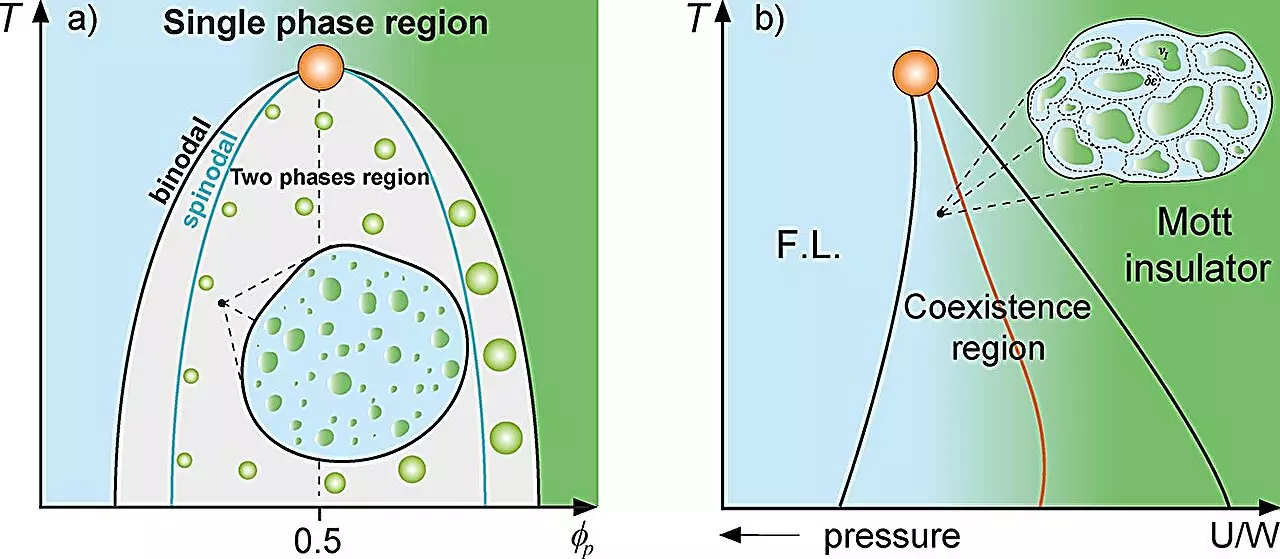The relationship between physical systems and biological processes has drawn considerable interest in recent years, particularly in the context of protein compartmentalization within cells. The explorations undertaken by a team of researchers from São Paulo State University (UNESP) draw parallels between classical physics—specifically classical mixture theory—and the behavior of proteins in biological environments. By leveraging concepts from condensed matter physics, the researchers have proposed a Griffiths-like cellular phase that mirrors the behavior of magnetic systems, shedding light on the intricate dynamics at play within cellular structures.
The essence of this research lies in understanding how various substances interact and exist in different phases. A classic example can be found in the coexistence of both high and low-density phases in supercooled water. Similarly, the study posits that proteins can exist in distinct phases within cellular environments, leading to phenomena such as liquid-liquid phase separation. This has profound implications for cellular processes and biological organization, as it allows proteins to form droplets that compartmentalize biochemical reactions.
The concept of the Griffiths phase originates from the study of magnetism and involves the emergence of “rare regions” within a material. These regions lead to diminished mobility and dynamics of the system as a whole. The researchers at UNESP have adapted this concept to biological systems, suggesting that protein compartments—akin to magnetic Griffiths phases—can influence cellular dynamics significantly.
According to the lead researcher Mariano de Souza, these protein droplets can exhibit reduced movement, analogous to the magnetization states observed in magnetic materials. The study meticulously employs thermodynamic tools, such as the Grüneisen parameter and Flory-Huggins model, to analyze the phase behavior of proteins under varying conditions, aiming to establish a direct analogy with established physical theories. This innovative approach has profound implications for our understanding of cellular organization and the biophysics governing it.
Beyond mere compartmentalization, the study controversially links the Griffiths-like cellular phase to the origins of life itself. Souza draws from classical theories posited by Russian biologist Aleksandr Oparin, suggesting that primitive life forms may have emerged in environments characterized by slow-moving chemical states—where liquid-liquid phase separation was prevalent.
A critical factor in this narrative is chirality, a fundamental property of molecules that influences the chemical and physical behavior of biological systems. The predominance of a single chirality within molecules—termed homochirality—played a pivotal role in the evolution of life, particularly in the formation and stability of organic compounds. The researchers assert that the cellular dynamism described in their study is inherently linked to these chirality-driven processes, potentially illuminating the path from simple organic molecules to complex life forms.
A significant portion of the research highlights the medical implications of understanding protein compartmentalization. The phenomenon of liquid-liquid phase separation has garnered attention in the context of several diseases, including various cancers and neurodegenerative disorders. The researchers explore how aberrant compartmentalization could lead to altered gene expression and protein functions, ultimately contributing to disease progression.
Professor Marcos Minicucci, a co-author of the study, emphasizes the critical role that this understanding can play in treating diseases, noting that specific proteins associated with pathologies might behave differently when compartmentalized. By presenting an alternative paradigm for investigating these dynamics, this research could significantly impact therapeutic strategies, particularly in designing interventions for diseases characterized by detrimental phase separations.
A noteworthy aspect of this study is its emphasis on interdisciplinary collaboration. The fusion of physics, biology, and medical sciences not only enhances the depth of exploration but also opens new avenues for research. The diverse backgrounds of the research team members contribute to a more holistic understanding of complex biological phenomena, showcasing the value of collaborative science.
The research from UNESP presents a compelling framework for understanding protein dynamics through a new lens. By applying principles of classical physics, the team elucidates the complexities of cellular compartmentalization and its implications for the origins of life and disease processes. As science continues to unravel the interconnectedness of disciplines, such studies pave the way for innovative approaches to addressing some of life’s most intricate questions.


Leave a Reply